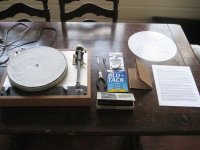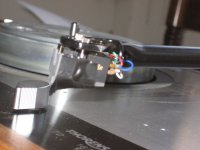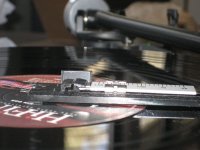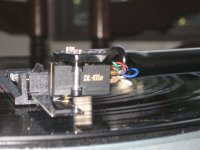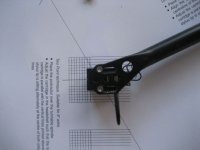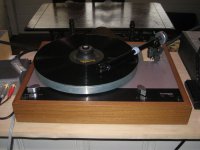So, my Dynavector 10x5 high-output MC was about to kick the can (sounded lifeless and had about three years of faithful service) and I decided I'd like to try a low-output MC. I had considered a low-output Benz Micro Ace, but an old friend talked me into the Denon DL-103R.
My setup is a Thorens TD-160 with a Rega RB-250 tonearm, which causes a bit of a mismatch for the Denon-DL-103R, for two main reasons:
1. The Rega arms appear to not allow (at least initially) the proper overhang for the Denon cartridge-- it misses it by about a millimeter. Like Mrs. Annan, the DL-103R is built solid and really old school, i.e., the mounting inset is located really close to the needle, leaving not much room for forward adjustment in the Rega headshell.
2. The compliance of the Denon DL-103R is akin to that of a Pullman Car, that is, it's rated as a 5 x 10-6 cm/dyne which means a high-mass tonearm is required to control this monster. The Rega, at around 12g - 13g (depending on who you believe) is not officially up to the task in it's stock form.
Furthermore, I needed a step-up device to address the .25mV output of the DL-103R.
After a short commercial break, we'll tell you what happened and hopefully add to the discourse by becoming part of the solution for once.
<Insert Cialis commercial here>
OK-- here's the schematic for the MC stepup I used, which was provided by Thorsten some time ago. More pictures and clever, snappy narrative to come.
Kofi
My setup is a Thorens TD-160 with a Rega RB-250 tonearm, which causes a bit of a mismatch for the Denon-DL-103R, for two main reasons:
1. The Rega arms appear to not allow (at least initially) the proper overhang for the Denon cartridge-- it misses it by about a millimeter. Like Mrs. Annan, the DL-103R is built solid and really old school, i.e., the mounting inset is located really close to the needle, leaving not much room for forward adjustment in the Rega headshell.
2. The compliance of the Denon DL-103R is akin to that of a Pullman Car, that is, it's rated as a 5 x 10-6 cm/dyne which means a high-mass tonearm is required to control this monster. The Rega, at around 12g - 13g (depending on who you believe) is not officially up to the task in it's stock form.
Furthermore, I needed a step-up device to address the .25mV output of the DL-103R.
After a short commercial break, we'll tell you what happened and hopefully add to the discourse by becoming part of the solution for once.
<Insert Cialis commercial here>
OK-- here's the schematic for the MC stepup I used, which was provided by Thorsten some time ago. More pictures and clever, snappy narrative to come.
Kofi
After building the MC stepup, I ordered the following:
* Denon DL-103R (these guys were really fast).
* Hi-Fi News test record
* Shure tracking force gauge
* Blu-Tack
* Rega VTA Adjuster
Once all arrived, I started the installation process...
Kofi
* Denon DL-103R (these guys were really fast).
* Hi-Fi News test record
* Shure tracking force gauge
* Blu-Tack
* Rega VTA Adjuster
Once all arrived, I started the installation process...
Kofi
Attachments
Getting the old cartridge off was a piece of cake, but they don't make it easy to mount the Denon. Not only are there are there no threaded insets, but there's no actual "hole" either. There's just a half-moon indentation where the screw goes.
Furthermore, it's not an allen key-- it's a tiny slotted screwdriver head that faces downward, where almost no screwdriver can go. Try that with only two hands and a hangover.
My solution was to keep the screws in place with a little electrical tape lightly affixed to the cartridge. I just needed to get the nuts started, so the tape worked perfectly.
Furthermore, it's not an allen key-- it's a tiny slotted screwdriver head that faces downward, where almost no screwdriver can go. Try that with only two hands and a hangover.
My solution was to keep the screws in place with a little electrical tape lightly affixed to the cartridge. I just needed to get the nuts started, so the tape worked perfectly.
Attachments
Now the tricky bit-- getting the cartridge aligned in the headshell.
This took a good amount of time, but I finally got it correct. I was able to get a two-point agreement using the Hi-Fi news protractor, but again, the overhang was short by 1mm (actually, it was more like .8mm).
This I didn't sweat.
This took a good amount of time, but I finally got it correct. I was able to get a two-point agreement using the Hi-Fi news protractor, but again, the overhang was short by 1mm (actually, it was more like .8mm).
This I didn't sweat.
Attachments
Finally, I used the Hi-Fi news record to fine tune. I was able to track all of the first side except for Track 9 (the "torture track"), which was expected.
On the second side of the LP, I had expected to find that that the resonant frequency of the arm / cartridge combination was too high, which is exactly what I did find.
The initial results were that the resonant frequency was about 17Hz. I was looking for something in the 8Hz - 12Hz range, so I needed to modify the arm to add some mass. Here's where the intense customization came into play.
This took lots of time and lots of cash. I bought a milling machine to mill about two grams worth of perfectly-balanced titanium which I then sent through an electrolytic bath (which I also purchased) to ensure proper molecular alignment (good for proper resonance).
I affixed the final product to the tonearm at the impedance / resonance peak which was found using the following formula:
w = ∫ HdB + ∫ EdD 1 + αT 1
With the help of an electron microscope (eBay) I then fused the mass to the tonearm at the precise point above using a small, but powerful laser (found in trash outside apartment complex).
You can see the results below.
I admit that it looks like a $.07 blob of Blu-Tack wrapped around the tonearm, but in reality, it cost about $1.8 million after all parts were purchased. Well, in retrospect, I guess you could just use the Blu-Tack.
I had to readjust the downward tracking force and the anti-skate once the mass was added, but I was able to get the resonant frequency down to about 11Hz, which is good enough for government work.
On the second side of the LP, I had expected to find that that the resonant frequency of the arm / cartridge combination was too high, which is exactly what I did find.
The initial results were that the resonant frequency was about 17Hz. I was looking for something in the 8Hz - 12Hz range, so I needed to modify the arm to add some mass. Here's where the intense customization came into play.
This took lots of time and lots of cash. I bought a milling machine to mill about two grams worth of perfectly-balanced titanium which I then sent through an electrolytic bath (which I also purchased) to ensure proper molecular alignment (good for proper resonance).
I affixed the final product to the tonearm at the impedance / resonance peak which was found using the following formula:
w = ∫ HdB + ∫ EdD 1 + αT 1
With the help of an electron microscope (eBay) I then fused the mass to the tonearm at the precise point above using a small, but powerful laser (found in trash outside apartment complex).
You can see the results below.
I admit that it looks like a $.07 blob of Blu-Tack wrapped around the tonearm, but in reality, it cost about $1.8 million after all parts were purchased. Well, in retrospect, I guess you could just use the Blu-Tack.
I had to readjust the downward tracking force and the anti-skate once the mass was added, but I was able to get the resonant frequency down to about 11Hz, which is good enough for government work.
Attachments
Hi kofi,
I run the denon 103 on a SME 3009 III (TD 125), this being a lower mass arm.
I tested - watching via the deq 2496 rta and listening - with the audio test record developed by flloyd toole, and found this system just excellent.
There might be some resonance below 20 Hz, but the rta not extending that far, I cannot say and it doesn't matter. The pink noise response is almost flat, and the system reproduces to +6db level without audible distortion - compared to the lower levels.
Theoretically it shouldn't work, but it does just fine. I also have the dl 103 on another td 125 with the airbearing MG1 arm (also a low mass arm) without any problems.
PS - no weight added and welded with any type of machinery.
I run the denon 103 on a SME 3009 III (TD 125), this being a lower mass arm.
I tested - watching via the deq 2496 rta and listening - with the audio test record developed by flloyd toole, and found this system just excellent.
There might be some resonance below 20 Hz, but the rta not extending that far, I cannot say and it doesn't matter. The pink noise response is almost flat, and the system reproduces to +6db level without audible distortion - compared to the lower levels.
Theoretically it shouldn't work, but it does just fine. I also have the dl 103 on another td 125 with the airbearing MG1 arm (also a low mass arm) without any problems.
PS - no weight added and welded with any type of machinery.
Kofi Annan said:
2. The compliance of the Denon DL-103R is akin to that of a Pullman Car, that is, it's rated as a 5 x 10-6 cm/dyne which means a high-mass tonearm is required to control this monster. The Rega, at around 12g - 13g (depending on who you believe) is not officially up to the task in it's stock form.
Not quite. Denon specify compliance at 100 Hz, which is irrelevant as we want the number at about resonance point, i.e. 10Hz (at least Denon have the decency of stating at which frequency they measure). The compliance of a DL-103* at 10Hz is significantly larger, possibly 8-10 x 10-6 cm/dyne.
Kofi Annan said:able to get a two-point agreement using the Hi-Fi news protractor, but again, the overhang was short by 1mm
I never failed aligning DL-103s in Rega arms using any of the standard templates. Is your arm base to spindle distance correct?
Kofi Annan said:
The initial results were that the resonant frequency was about 17Hz.
...
I then fused the mass to the tonearm at the precise point
...
once the mass was added, but I was able to get the resonant frequency down to about 11Hz, which is good enough for
Something is wrong here. The resonance frequency is inversely proportional to the square root of the effective mass. In order to reduce Fres from 17Hz to 11Hz one would have to increase effective mass by the staggering amount of 28g or so, something your million dollar blob of blutack never did.
Here's my solution for DL-103s:
http://www.tnt-audio.com/sorgenti/analogue_bits_e.html
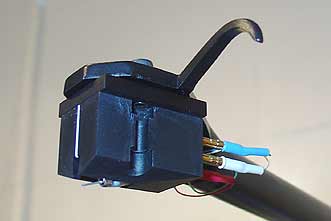
Not quite. Denon specify compliance at 100 Hz, which is irrelevant as we want the number at about resonance point, i.e. 10Hz (at least Denon have the decency of stating at which frequency they measure). The compliance of a DL-103* at 10Hz is significantly larger, possibly 8-10 x 10-6 cm/dyne.
This is interesting... so it's a bit more compliant than we thought, eh?
I never failed aligning DL-103s in Rega arms using any of the standard templates. Is your arm base to spindle distance correct?
Well, I'm right at 222mm base-to-spindle distance, which puts me short on the overhang by about 1mm. Hopefully, this is no big deal as remounting the arm would take some frustrating work. I had to make my own armboard out of MDF, so I'd need to make another one to shorten the distance by 1mm.
Something is wrong here. The resonance frequency is inversely proportional to the square root of the effective mass. In order to reduce Fres from 17Hz to 11Hz one would have to increase effective mass by the staggering amount of 28g or so, something your million dollar blob of blutack never did.
Of course, you're right. I probably just imagined the 17Hz initially. The Hi Fi news record I received is a bit warped and caused some initial problems reading the resonant frequency. Looking back, it was probably lower.
Here's my solution for DL-103s:
Elegant!
Man. This makes my solution look like a blob of Blu-Tack.
Kofi
Don't worry. I have many solutions involving blue blobs. I just never make pictures of them.
As for the DL-103, there's a whole cult on http://www.audioasylum.com
who strip 103s and mount them into heavier wood enclosures.
As for the DL-103, there's a whole cult on http://www.audioasylum.com
who strip 103s and mount them into heavier wood enclosures.
Re: Re: Kofi Annan in: "Installin' the Denon (DL-103R)"
Argh!
Now I can no longer blame Denon's compliance for the wild woofer cone movement my speakers demonstrate when I listen to vinyl.
And I was actually contemplating on a highly sophisticated solution involving expensive hi-tech gear and blu-tack, myself!
Werner said:The compliance of a DL-103* at 10Hz is significantly larger, possibly 8-10 x 10-6 cm/dyne.
Argh!

Now I can no longer blame Denon's compliance for the wild woofer cone movement my speakers demonstrate when I listen to vinyl.

And I was actually contemplating on a highly sophisticated solution involving expensive hi-tech gear and blu-tack, myself!
OK, you can control the resonance frequency by adding mass, but how do you control the damping? I have an unlucky combination of DL-103 and Mayware unipivot arm that wobbles like hell on some tracks. The silicone damping at the pivot chamber is not enough to get critical damping, and I suppose there is no way of adding/modifying damping on other traditional arms, either. The only control is the internal damping element of the stylus within the cartridge.
As for the DL-103, there's a whole cult on http://www.audioasylum.com
I've seen this before. There's a guy who sells these on eBay and there's a "modified" version from Zu Audio as well.
OK, you can control the resonance frequency by adding mass, but how do you control the damping?
Just an idea, but do you have the the cartridge mounted as is? Maybe a rigid plate / wood body or another such mounting coupler / decoupler would help?
Experts?
Kofi
He refers to the damping of the total mass vs cantilever compliance resonant system. You can only influence that either by adding external resistivity (such as the Shure damper) or by directly messing with the cartridge's innards (which is perfectly feasible if your name ends with Van den Hul, Allaerts, Carr, or Hanekom).
Denon 103r "Bits"
Werner,
I have recently purchased the 103r and I am finding out that I have these issues the cart not being tall enough, heavy enough, and the super long screws to be a pain.
It seems like your solution would be wonderful. I am interested in purchasing one of these "bits" from you. Would you happen to have an extra?
Ramon
Werner,
I have recently purchased the 103r and I am finding out that I have these issues the cart not being tall enough, heavy enough, and the super long screws to be a pain.
It seems like your solution would be wonderful. I am interested in purchasing one of these "bits" from you. Would you happen to have an extra?
Ramon
- Status
- This old topic is closed. If you want to reopen this topic, contact a moderator using the "Report Post" button.
- Home
- Source & Line
- Analogue Source
- Kofi Annan in: "Installin' the Denon (DL-103R)"
